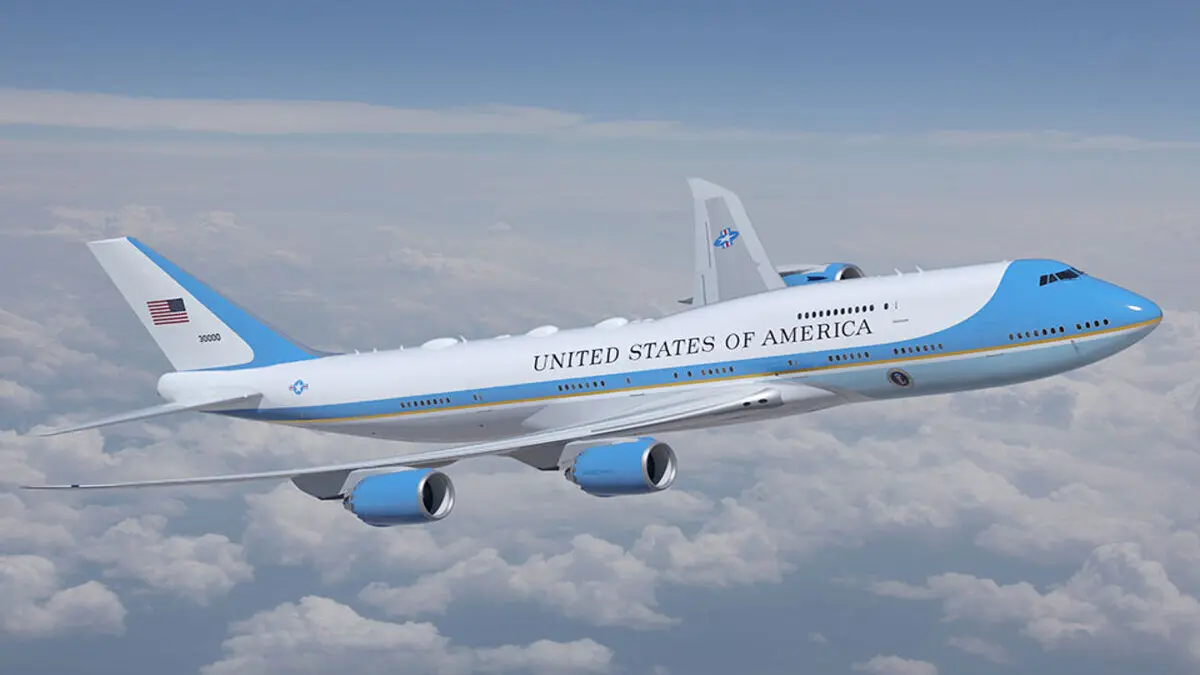The U.S. Air Force is reallocating surplus funds from its Sentinel intercontinental ballistic missile (ICBM) modernization program to refurbish a Boeing 747-8 aircraft as an interim presidential transport. The refit ensures continuous executive airlift capability amid delays in the next-generation Air Force One, leveraging the 747-8’s advanced performance and efficiency over the older 747-200 platform.
(WASHINGTON, D.C.) – In a strategic decision to preserve uninterrupted presidential airlift capabilities, the U.S. Air Force has announced the reallocation of surplus fiscal year 2024 funds from its Sentinel intercontinental ballistic missile (ICBM) modernization program to support the modification of a Boeing 747-8 aircraft.
The aircraft, previously owned by Qatar, is undergoing extensive conversion at Fort Worth Alliance Airport to serve as an interim Air Force One. This comes as the next-generation VC-25B program faces production delays, with its first deliveries expected between 2028 and 2029.
Inside the Refit: Advanced Systems and Presidential Features
The refit will equip the aircraft with a suite of advanced systems to meet national security, communications, and presidential mission standards. Planned upgrades include:
- Secure Communications: Encrypted, resilient communication systems to ensure constant contact with defense and civilian leadership.
- Defensive Countermeasures: Advanced threat detection and countermeasure systems for in-flight security.
- Structural and Cabin Modifications: Airframe reinforcements, internal reconfigurations, and presidential accommodations.
- Avionics Enhancements: Upgrades to navigation, flight management, and cockpit systems for modern operational needs.
- Interior Customization: Specialized configurations to support mission planning, in-flight work, and presidential comfort.
Air Force officials estimate that the refit will cost under $400 million, with completion anticipated in under a year. The interim aircraft is slated for use until the VC-25B becomes operational.
Why the 747-8 Was Chosen: Key Performance Benefits
The Boeing 747-8 offers significant advantages over the aging 747-200-based VC-25A aircraft currently in service. Originally designed as a next-generation successor, the 747-8 delivers superior performance in several areas:
1. Greater Range and Fuel Efficiency
The 747-8 features advanced General Electric GEnx-2B67 engines, which provide improved fuel efficiency and reduce emissions. Its maximum range exceeds 7,700 nautical miles—substantially more than the VC-25A’s roughly 6,800-nautical-mile range—allowing for longer, non-stop global flights with fewer refueling requirements.
2. Modern Avionics and Flight Systems
The aircraft incorporates digital avionics, fly-by-wire systems, and enhanced flight controls, reducing pilot workload and improving operational flexibility. Its navigation systems are more advanced, offering increased precision and situational awareness.
3. Larger Payload and Cabin Volume
The 747-8 is the longest passenger aircraft in the world, offering more usable floor space than the 747-200. This allows for expanded onboard work areas, additional communication suites, medical facilities, and enhanced living quarters for the President and accompanying personnel.
4. Quieter and Smoother Ride
Thanks to its new-generation engines and wing design, the 747-8 delivers a quieter, smoother ride compared to the older VC-25A, improving both comfort and operational discretion.
5. Sustainability and Maintenance
As a newer platform, the 747-8 benefits from greater parts availability and requires less intensive maintenance than the aging VC-25A, whose spare parts are increasingly scarce due to its outdated design.
The Boeing VC-25A is a highly modified version of the Boeing 747-200B, with only two aircraft in service, bearing tail numbers 28000 and 29000. While the designation “Air Force One” technically applies only when the President is aboard, the term is commonly used to refer to the VC-25A itself.
Purposeful Fund Reallocation
According to the Air Force, some Sentinel program funds were available due to construction rescheduling and project adjustments, which freed up fiscal year resources without impacting overall program execution.
“The Sentinel program remains fully funded and on schedule,” an Air Force spokesperson confirmed. “This reallocation enables us to address a high-priority national requirement without compromising strategic modernization.”
Timeline and Outlook
- May 2025: Aircraft delivered to the U.S.
- June 2025: Fund reallocation announced for refit.
- Late 2026: Aircraft expected to enter operational service.
- 2028–2029: VC-25B aircraft planned for delivery and service entry.
Officials emphasize that the interim aircraft will meet the Air Force’s rigorous standards for presidential airlift, ensuring no gap in capability.
Conclusion
By leveraging the advanced capabilities of the Boeing 747-8 and reallocating available funds from the Sentinel program, the U.S. Air Force is addressing a critical need for continuous, secure presidential transport. The refit highlights both strategic foresight and operational efficiency, maintaining readiness while awaiting the next-generation VC-25B aircraft.
Recommended to Read: Anti-Aircraft Systems Bound for Ukraine Found Abandoned in Polish Hangar
FAQs
The U.S. Air Force is upgrading the Boeing 747-8 as an interim presidential aircraft as the new VC-25B program is delayed. The 747-8 offers better fuel efficiency, longer range, more space, and advanced systems than the older VC-25A, ensuring consistent and safe presidential air travel.
The refit is estimated to cost less than $400 million. Work began after funds were reallocated from the Sentinel ICBM program, and the aircraft is expected to enter service by the end of 2026, providing reliable presidential transport until the VC-25B arrives in 2028-2029.
The refit includes secure communications systems, defensive countermeasures, advanced avionics, structural modifications, and customized interior spaces. These upgrades ensure safety, comfort, and mission readiness for the President and staff during global flights.








Leave a Reply